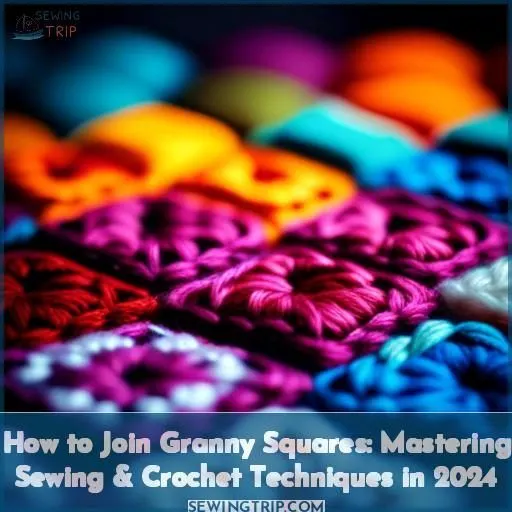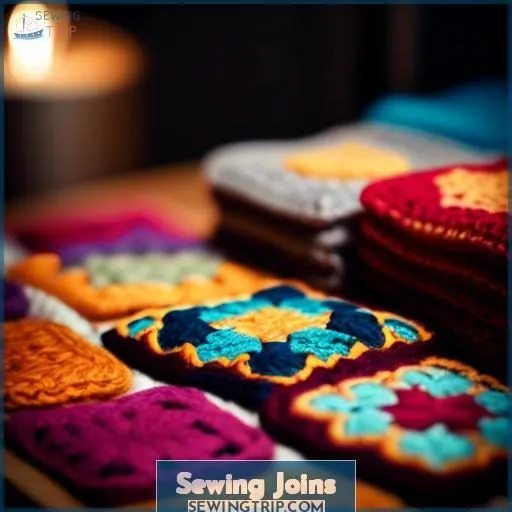This site is supported by our readers. We may earn a commission, at no cost to you, if you purchase through links.

For an invisible seam, try the mattress stitch or invisible whip stitch. Weave the yarn neatly between the granny square stitches for a seamless look.
The no-sew join-as-you-go method is quick and creates flat, tidy seams as you attach squares while crocheting.
Whichever technique you choose, keep your stitches even and tension consistent.
The right joining method elevates your blanket, ensuring granny squares unite flawlessly.
Explore further to master sewing and crochet joins that bring professional polish.
Table Of Contents
- Key Takeaways
- How to Join Granny Squares by Sewing?
- Sewing Joins
- Crochet Joins
- Decorative Joins
- Zig Zag Braid Join
- Ladder Stitch Join (Mattress Stitch Join)
- Creates Texture (Single Crochet Join, Reverse Single Crochet Join)
- Completely Flat Seam (Invisible Seam Join, Invisible Stitch Join)
- Raised and Textured Line (Reverse Single Crochet Join)
- Decorative and Lacey (Zig Zag Braid Join)
- Fast to Crochet (Zig Zag Braid Join)
- No Sewing Required (Slip Stitch Join)
- No Crochet Hooks Required (Invisible Seam Join)
- Takes Practice to Master (Reverse Single Crochet Join)
- Conclusion
Key Takeaways
- To achieve an invisible seam when joining granny squares by sewing, the mattress stitch or invisible whip stitch are recommended methods, as they weave the yarn between the stitches for a seamless finish.
- The join-as-you-go method allows for joining granny squares without sewing, creating flat and tidy seams as you crochet, which is quick and eliminates the need for later sewing.
- When using the whip stitch join, it’s important to consider variations of the stitch, needle size, and yarn weight to ensure the seam is even and matches the rest of the project in appearance and tension.
- The invisible stitch join is a sewing technique that uses a slip or ladder stitch to create a nearly undetectable seam, ideal for a flat finish on the right side of the fabric.
How to Join Granny Squares by Sewing?
To join granny squares by sewing, one popular method is the whip stitch, which involves sewing over the edge of the squares for a flexible seam. Another technique is the invisible stitch, creating a hidden seam by threading yarn through the back loops of the squares.
Sewing Joins
You can join granny squares using sewing techniques such as the whip stitch join, where you weave the yarn in and out between stitches.
Another option is the invisible stitch join, which creates an almost seamless look on the right side of the fabric.
You can also use the invisible seam join, achieved by sewing the squares together on the wrong side, resulting in a flat, smooth seam on the right side.
Whip Stitch Join
Whip stitch joins are a popular option for connecting granny squares or other crochet pieces. Here are three crucial aspects to keep in mind when employing whip stitch joins:
- Whip stitch variations: Whip stitch can be executed in various ways, such as through the top layer only or through both layers. The choice depends on the desired seam finish and the type of fabric used.
- Needle size considerations: The needle size utilized for whip stitching can influence the stitch width and overall appearance of the seam. Larger needles may create a more noticeable seam, while smaller needles can result in a more subtle seam.
- Yarn weight impact: The weight of the yarn being used can also affect the appearance of the whip stitch join. Finer yarns may create a more delicate seam, while coarser yarns can result in a more substantial seam.
In terms of visibility, whip stitch joins can range from nearly unnoticeable when using matching thread on crocheted works to more visible on sewn works, where the stitch can be hidden or displayed. Whip stitch joins are also recognized for their durability and ability to prevent fabric from unraveling, making them appropriate for various projects, including felt crafts and st■ toys.
Invisible Stitch Join (sewing)
Invisible stitch join is a sewing technique that involves using a slip or ladder stitch to sew up open seams from the outside of a sewn item, making the stitches almost invisible.
This method is commonly used to close up the final section of open seam on st■ toys or cushions.
To perform an invisible stitch join, you can use a sewing machine, hand sewing, needle and thread, or fabric glue.
The invisible stitch join can be used to create a completely flat seam, which is suitable for projects where you want to avoid any raised or textured lines.
However, it may not be suitable for projects where holes may be a hazard, such as in the case of a zig zag braid join.
Invisible Seam Join (sewing)
Invisible Seam Join is a sewing technique that involves using a needle and thread or a sewing machine to join two pieces of fabric together without creating visible stitches.
This method is perfect for joining granny squares**, as it creates a seam that’s almost undetectable.
If you prefer not to sew, you can also use fabric glue or a Zig Zag Braid Join for a decorative touch.
For more tips on how to join granny squares by sewing, check out an in-depth guide on crochet granny squares.
Join-as-You-Go Method (sewing)
Joining granny squares without sewing is a breeze with the Join-as-you-go (JAYGO) method. This technique allows you to attach each square to the previous one as you make them, eliminating the need for sewing. Here’s a step-by-step guide on how to join granny squares using the JAYGO method:
- Planning: Before you start joining, make sure you have all your granny squares ready. Each square should have a complete round before you start joining.
- Joining: Start by joining the first square to the second one. You can use a slip stitch to join the squares.
- Continuing: After joining the first two squares, you can continue joining the remaining squares in the same manner. Remember to work the final round of each square and join it to the adjacent square with a slip stitch at corresponding points.
- Seamless: The JAYGO method creates a seamless join between the squares, making it ideal for projects where you want a flat seam without any actual seaming.
- Practice: Like any new skill, mastering the JAYGO method takes practice. Don’t worry if you don’t get it right away. Keep trying and you’ll get the hang of it.
Chain Join Method (sewing)
Diving into the Chain Join Method, you’re stitching your way to innovation. Here’s how:
- Match your needle size and yarn weight to guarantee seamless tension.
- Weave with precision, creating a chain that boasts seam strength.
- Revel in the satisfaction of a job well done.
Crochet Joins
Crochet joins offer a seamless and visually appealing method for connecting granny squares, providing techniques like the single crochet join, slip stitch join, and reverse single crochet join. These versatile approaches both secure the motifs together and create unique textures, raised lines, or flat surfaces, meeting diverse project needs and design preferences.
Single Crochet Join
The Single Crochet Join is a popular method for joining granny squares.
It’s a simple, quick, and easy technique that creates a textured seam.
To make a Single Crochet Join, you’ll start by making a slip stitch into the first square.
Then, you’ll chain one and make a single crochet stitch into the second square.
Continue this process, making a single crochet stitch into each subsequent square until the join is complete.
This join is great for those who want to create a decorative and textured seam without the need for sewing.
Slip Stitch Join
After perfecting the single crochet connection, let’s embark on the slip stitch connection.
This method is groundbreaking, creating a completely level seam with an intertwined appearance that’s both refined and durable.
It incorporates spaces for a subtle touch, eliminating the need for crochet hooks or stitching, making it a smooth progression in your granny square journey.
It’s like enchantment without the wand!
Reverse Single Crochet Join
Ready to master the Reverse Single Crochet Join? This technique creates a raised seam with a textured line, perfect for adding a unique touch to your crochet projects. Here’s a step-by-step guide:
- Reverse Stitch: Start by reversing your stitch, creating a chain stitch on the wrong side of your work.
- Crochet Hook: Use a crochet hook to work the first row of single crochet stitches in the chain stitches you just created.
- Holes Hazard: Be careful not to leave any gaps or holes, as this join isn’t suitable for projects where holes may be a hazard.
- Practice: Like any new skill, practice makes perfect. Take your time and soon you’ll be a Reverse Single Crochet Join pro!
Flat Slip Stitch Join
The Flat Slip Stitch Join is a popular crochet technique for joining granny squares. It creates a seam that’s flat, neat, and tidy, as the name suggests. This method involves working through the back loops of your stitches, which makes sure that the seam lies flat and isn’t visible on the right side of your work. The process begins by inserting your hook from front to back into the back loop of a stitch from the edge on one of the squares, then continuing with the next stitch on the other square. You’ll alternate which side you insert your hook into first, working from left to right and then from right to left, and continue this pattern as you work the seam.
One of the advantages of the Flat Slip Stitch Join is that it’s suitable for both right-side and wrong-side seams, making it versatile for various projects. It also allows for a contrasting yarn color to be used, which can create a visually stunning effect. However, it’s essential to make sure that the yarn is always at the back of your work and to maintain a loose tension while working the slip stitches to prevent the seam from being too tight.
This method is particularly useful for those who prefer not to sew, as it doesn’t require any sewing skills. It’s also a quick and easy way to join crochet squares, making it an excellent choice for those who are looking to complete their projects efficiently.
Double Crochet Join
Double crochet join is a versatile technique that offers several advantages.
It’s suitable for various crochet patterns, including those with intricate designs.
Moreover, double crochet join is quick and easy to master, making it a popular choice for beginners.
However, it may not be suitable for all projects, as it can create a raised and textured line that may not be desired in certain situations.
Additionally, there are several double crochet join variations to explore, such as the flat braid join and the simulated braid join, which can add texture and dimension to your work.
To master double crochet join, consider using resources like pattern books, online tutorials, and crochet communities.
Join-as-You-Go Method (crochet)
Embrace the ‘Join-as-You-Go Method‘ in crochet, where you seamlessly attach each square to the next without the need for backtracking. This technique is perfect for corner crochet, as it allows for continuous joining without the hassle of concealing seams. When using this method, consider your yarn selection and tension management to guarantee a seamless finish.
Flat Braid Join Method
Mastering the flat braid join method is a must for anyone looking to join granny squares.
This beginner-friendly technique involves creating a flat braid seam that adds texture and visual interest to your project.
With a bit of practice, you’ll be able to seamlessly connect your squares without the need for sewing or any special tools.
It’s a great way to enhance your crochet skills and create beautiful, cohesive projects.
Simulated Braid Join Method
To achieve a braided appearance with a raised texture, try the Simulated Braid Join Method. Here’s how:
- Start by chaining 3-4 stitches.
- Join the next stitch with a slip stitch.
- Insert the hook into the next stitch, yarn over, and pull through the loop.
- Yarn over and pull through the first two loops on the hook.
- Insert the hook into the next stitch and repeat steps 3-5.
- Continue this pattern until you have joined all your stitches.
This method creates a decorative lacing effect without any sewing required, and it’s perfect for those who don’t want to use crochet hooks. No need to worry about mastering a new technique; it’s easy to learn and adds a unique touch to your granny squares.
Scallop Join Method
To create a scallop join in your crochet project, you’ll need to follow these steps:
- Lay out your squares in your desired arrangement.
- Pick up pairs of adjacent squares and join them with your chosen stitch (slip stitch or single crochet).
- When you have joined all the squares in rows, repeat the process to join them in columns.
- If you’re using the join-as-you-go method, crochet the final round of a square and, before making each stitch or cluster of stitches, work a slip stitch into the corresponding stitch or space of any adjacent squares that have already been joined.
- Continue joining squares in this manner until your project is complete.
This join method will result in a relatively flat and inconspicuous seam, especially if worked on the right side of your project. The scallop shape is created by the joining sequence, which forms a decorative pattern on the outer edges of your project. Remember to choose the appropriate yarn tension and hook size for your project to guarantee a consistent scallop shape throughout.
Fancy Join Method
Ready to elevate your granny square game to the next level?
Let’s embark on the Fancy Join Method.
This technique is ideal for those who wish to imbue their projects with a touch of grace.
With the Fancy Join Method, you can craft unnoticeable, textured, and interwoven seams that are both decorative and needle-free.
No crochet hooks necessary, merely your reliable granny square and a modicum of practice.
It’s time to enhance your crafting prowess and astound your fellow artisans.
Decorative Joins
You have several decorative options when joining granny squares.
Ranging from the zig zag braid join that creates a lacey, decorative effect.
To the ladder stitch join (also known as the mattress stitch join) that blends the squares seamlessly.
Some joins, like the single crochet and reverse single crochet, add texture.
While others, like the invisible seam join, result in a completely flat seam.
The reverse single crochet join produces a raised, textured line, taking practice to master.
Zig Zag Braid Join
After mastering the basics, it’s time to dazzle with the zig zag join, a decorative braid that elevates your crochet technique. This granny square finish additionally adds a lacey appearance and weaves a sense of belonging and innovation into your projects. Quick to crochet, it’s a fun twist that promises your creations will stand out in the crowd.
Ladder Stitch Join (Mattress Stitch Join)
The Ladder Stitch Join, also known as the Mattress Stitch Join, is a decorative seam that offers a clean and flat appearance.
It’s perfect for joining two pieces of fabric together without any visible stitches.
This join is strong and fast, making it an excellent choice for projects where you want a seam that won’t detract from the overall appearance.
It’s a bit more challenging to master than some other joins, but with a bit of practice, you’ll be able to create seamless, invisible seams in no time.
Creates Texture (Single Crochet Join, Reverse Single Crochet Join)
Mastering the art of joining granny squares is a journey of discovery, where texture plays a crucial role in generating visual appeal and enhancing durability. Here are three techniques that can help you achieve this:
- Single Crochet Join: This technique adds texture to your project, making it more visually captivating and durable. It’s quick and easy, but it may require some practice to perfect.
- Reverse Single Crochet Join: This join creates a raised and textured line, adding depth and interest to your project. It’s a bit more challenging than the single crochet join, but the result is worth the effort.
- Slip Stitch Join: This join is great for creating a completely flat seam, which is perfect for projects where a seamless appearance is desired. It’s also a great option for those who prefer not to sew or use crochet hooks.
Completely Flat Seam (Invisible Seam Join, Invisible Stitch Join)
After exploring the textured world of crochet, let’s drift into the ethereal domain of the invisible. Achieving a completely flat seam is like conjuring a spell with your fabric – no sewing, no crochet hooks, just swift and effortless techniques. The invisible stitch join murmurs secrets of seamless unions, making every piece seem as a solitary entity.
| Emotion | Technique | Result |
|---|---|---|
| Awe | Invisible Stitch | Unbroken Wholeness |
| Relief | No Sewing | Tranquil Serenity |
| Pride | Quick & Easy | Unrivaled Skill |
Raised and Textured Line (Reverse Single Crochet Join)
To create a raised and textured line, consider using the Reverse Single Crochet Join. This decorative stitch adds depth and dimension to your project. Here’s how to do it:
- Reverse Single Crochet Join: This stitch is a variation of the single crochet, but it’s worked in reverse. It creates a raised line that adds texture to your work.
- Textured Join: The Reverse Single Crochet Join is a textured join because it creates a raised line that adds depth and dimension to your project.
- Decorative Stitch: This stitch is a decorative stitch because it adds visual interest to your work. It’s a great choice for projects where you want to add a bit of flair.
- Single Crochet Join: To create a raised seam, you can also use the Single Crochet Join. This stitch creates a raised line that adds texture to your work.
Decorative and Lacey (Zig Zag Braid Join)
If you’re looking to add a touch of elegance and sophistication to your crochet projects, the Zig Zag Slip Stitch Join might just be the perfect choice for you. This decorative join method is known for its openwork design, which gives your projects a lacy, intricate appearance. It’s a great way to enhance the aesthetics of your crochet pieces, especially if you’re working on blankets or other textile items that require a stylish finish.
To create this join, you’ll need to start with a few pieces to join, such as completed solid granny squares. Then, you’ll make a slip stitch with the yarn for joining, keeping the working yarn under your pieces. Scoop up the yarn and pull through both the stitch and the loop, creating a zigzag pattern that slants to the left of the piece just worked. Continue this process, working from side to side, and remember to keep the working yarn under your work at all times.
One of the benefits of the Zig Zag Slip Stitch Join is that it adds texture to your crochet pieces, making them more visually appealing. It’s also a quick and easy method, which is always a bonus when you’re working on larger projects. And the best part? It’s surprisingly easy to do, even for beginners. So if you’re ready to add some flair to your crochet projects, give the Zig Zag Slip Stitch Join a try!
Fast to Crochet (Zig Zag Braid Join)
The Zig Zag Braid Join is a fast and easy crochet technique that adds a decorative lacey effect to your granny squares. Here’s how to do it:
- Start with a slip stitch join to create a flat base.
- Use a crochet hook one size smaller than your main hook.
- Work a row of single crochet stitches, skipping every other stitch.
- Turn and repeat on the other side.
This join is perfect for those who want to speed up their crochet process without sacrificing style.
No Sewing Required (Slip Stitch Join)
After zipping through the Zig Zag Braid Join, you’ll love the Slip Stitch Join for its simplicity.
Imagine joining corners with a magician’s finesse, creating an invisible seam that’s both quick and easy.
No crochet hooks waving around, no sewing nightmares.
It’s like your granny squares are holding hands, effortlessly.
Perfect for when you want to keep things smooth and seamless.
No Crochet Hooks Required (Invisible Seam Join)
The Invisible Seam Join is a technique that doesn’t require crochet hooks, making it a great alternative for those who want to avoid the hassle of switching between tools.
This method is perfect for joining fabrics with varying seam strength and fabric compatibility.
With the right needle size and thread choice, you can achieve a seam that’s as strong as traditional crochet joins.
Plus, the stitch length is adjustable, giving you control over the final look of your project.
Takes Practice to Master (Reverse Single Crochet Join)
Mastering the Reverse Single Crochet Join is a skill that requires practice.
This decorative join creates a raised, textured line, adding a unique touch to your projects.
It’s a bit tricky at first, but with time and patience, you’ll get the hang of it.
You’ll appreciate the flat seam it provides, which is a nice contrast to the zigzag braid join.
It’s also a great alternative to slip stitch joins when you want to add some texture.
So, grab your crochet hook and let’s get started!
Conclusion
Visualize your masterpiece: a treasured afghan adorned over your beloved armchair, granny squares flawlessly united.
By mastering how to join granny squares by sewing and crochet, you’ll enhance your endeavors.
Diligently practice the joins until effortless connections become instinctive.
With dedication and attention to detail, you’ll create heirloom-quality blankets that exhibit your diligently honed skills.
Embrace the journey, and delight in the fulfillment of unified, refined granny square creations.









